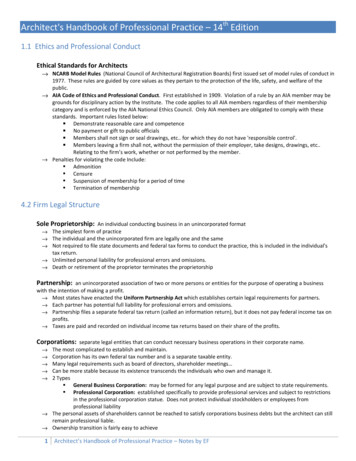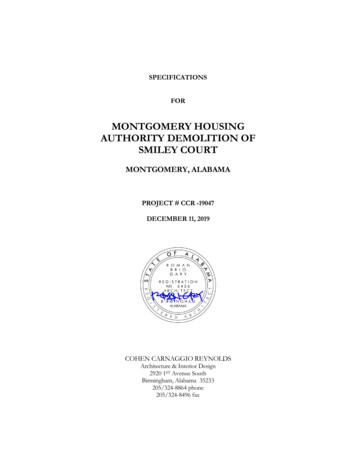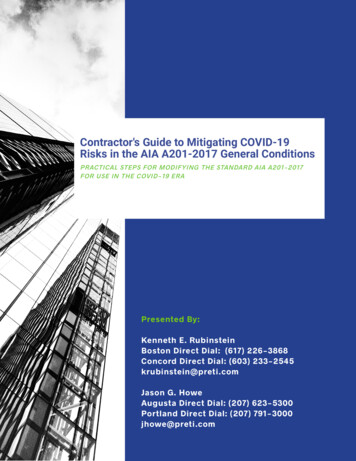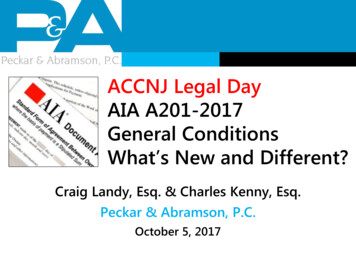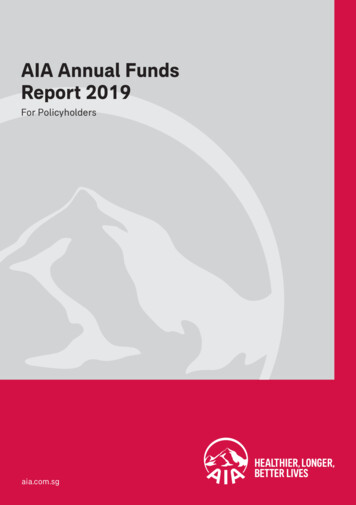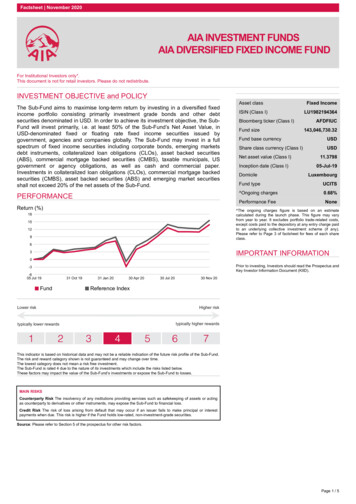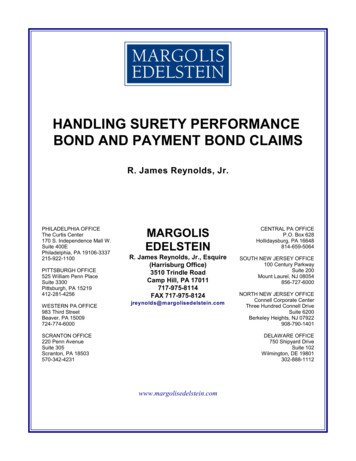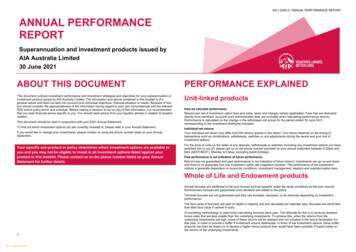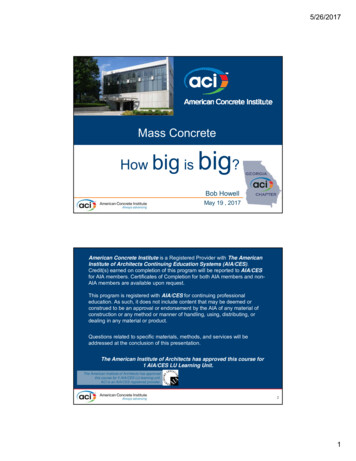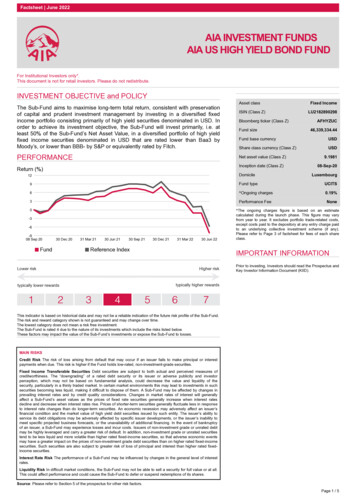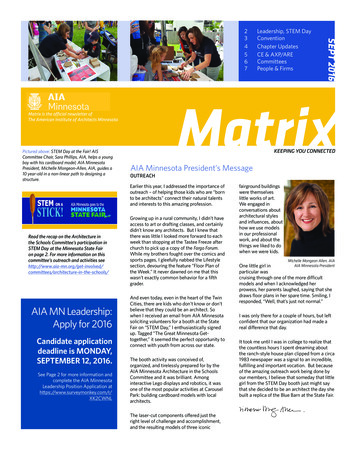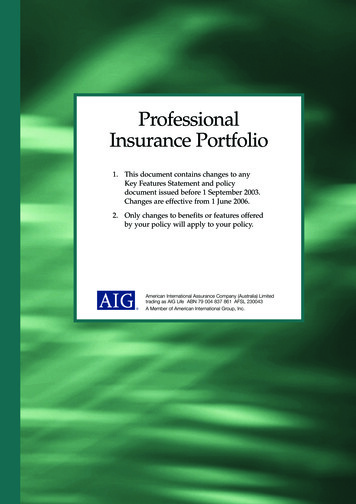
Transcription
ProfessionalInsurance Portfolio1. This document contains changes to anyKey Features Statement and policydocument issued before 1 September 2003.Changes are effective from 1 June 2006.2. Only changes to benefits or features offeredby your policy will apply to your policy.American International Assurance Company (Australia) Limitedtrading as AIG Life ABN 79 004 837 861 AFSL 230043A Member of American International Group, Inc.
YEARLY RENEWABLE TERM PLANTERM LIFE BENEFITPERMANENT DISABLEMENT ANDPERMANENT DISABLEMENT PLUS BENEFITSTerminal IllnessThe maximum benefit payable is increased to 100%of the Term Life sum insured up from 70%, up to 1,000,000.Maximum Sum InsuredIncreased from 2 million to 2.5 million foroccupation categories AAA, AA and A.CRISIS RECOVERY PLUS PLANCRISIS RECOVERY PLUS PLANMaximum Sum Insured Increased to 2m from 1.5m(ages 16 – 55 next birthday at entry). Also increased to 1.5m from 1m(ages 56 – 60 next birthday at entry).New Crisis Events Bacterial MeningitisBenign Brain TumourCardiomyopathyCoronary Artery AngioplastyLoss of HearingLoss of SpeechMajor Head TraumaViral EncephalitisCrisis Events – changed descriptions Leukaemia has been grouped under Cancer Alzheimer’s Diseases/Irreversible OrganicDisorder and Dementia have been combined intoDementia/Alzheimer Health Valve Replacement has been upgraded toHeart Valve Surgery.The Crisis Events covered under the Crisis RecoveryPLUS Plan under your policy are listed below andare defined in Appendix 1: Accidental HIV InfectionAplastic AnaemiaBacterial MeningitisBenign Brain TumourBlindnessCancer*CardiomyopathyChronic Liver DiseaseChronic Lung DiseaseComaCoronary Artery Angioplasty#Coronary Artery By-pass SurgeryDementia/Alzheimer’s DiseaseDiplegia Heart AttackHeart Valve SurgeryHemiplegiaKidney FailureLoss of HearingLoss of IndependenceLoss of Limbs and Sight of One EyeLoss of SpeechMajor BurnsMajor Head TraumaMajor Organ TransplantMotor Neurone DiseaseMultiple SclerosisMuscular DystrophyOther Serious Coronary Artery DiseaseParaplegiaParkinson’s DiseasePulmonary Arterial Hypertension (primary)QuadriplegiaStrokeSurgery to AortaViral Encephalitis* For ‘carcinoma in situ of the breast’, the benefitpayable will be limited to 25% of the CrisisRecovery PLUS sum insured, subject to amaximum payment of 25,000 under all policieswe have issued covering the life insured.# For Coronary Artery Angioplasty the benefitpayable for angioplasty of one or two coronaryarteries is limited to 25% of the Crisis RecoveryPLUS sum insured subject to a maximum of 25,000 under all policies we have issued coveringthe life insured. 100% of the Crisis Recovery PLUSsum insured will be payable for three or morecoronary arteries.After any payment for Cancer or Coronary ArteryAngioplasty, the Crisis Recovery PLUS sum insuredwill be reduced by the payment made. Once totalpayments under the Crisis Recovery PLUS Plan reachthe Crisis Recovery PLUS sum insured the CrisisRecovery PLUS Plan will cease.page 2 of 6
DISABILITY INCOME PLANDISABILITY INCOME BENEFITIndexation of BenefitCrisis Events – changed descriptionsThe level of cover will increase by 3% or theConsumer Price Index increase (whichever is thegreater). Leukaemia has been grouped under Cancer Alzheimer’s Diseases/Irreversible OrganicDisorder and Dementia have been combined intoDementia/Alzheimer Health Valve Replacement has been upgraded toHeart Valve Surgery.Increasing Claim BenefitBenefit has been renamed as the ’Claims EscalationBenefit’. The Monthly Benefit (Insured MonthlyBenefit) for Total Disablement will be increased by3% or the Consumer Price Index increase (whicheveris the greater) each year during the life of a claim.The Crisis Events now covered under the CrisisRecovery benefit under your policy document arelisted below and are defined in Appendix 1: Definition of ‘Waiting Period’Number of days the life insured can return to workfor during the Waiting Period before the waitingperiod starts again has improved to 5/10consecutive days.Where the Waiting Period is 14 or 30 days, the lifeinsured can now return to work during the WaitingPeriod for one or more periods of 4 or fewer dayswithout restarting the Waiting Period. Previouslyonce the life insured had returned to work for a totalor 5 or more days the Waiting Period restarted. Thischange means that the life insured can now return towork for more than 5 days in total without restartingthe Waiting Period provided each period for whichhe/she returns to work is for 4 or fewer consecutivedays. Where the Waiting Period is longer than 14days, the life insured can now return to work formore than 10 days in total without restarting theWaiting Period provided each period for whichhe/she returns to work is for 9 or fewerconsecutive days.Specified Injury benefitRemoved ‘within 48 hours of the injury’ from thedefinition of ‘Fracture’.Also, clarified the wording relating to the list ofbenefits that won’t be paid when a Specified Injurybenefit is being paid. Retrospective benefit is addedto the list.Accommodation benefitMaximum daily benefit increased to 250 (from 150)New Crisis Events Bacterial MeningitisBenign Brain TumourCardiomyopathyLoss of HearingLoss of SpeechMajor Head TraumaOccupationally Acquired Hepatitis B orHepatitis C Infection Viral Encephalitis Accidental HIV InfectionAplastic AnaemiaBacterial MeningitisBenign Brain TumourBlindnessCancer*CardiomyopathyChronic Liver DiseaseChronic Lung DiseaseComaCoronary Artery By-pass SurgeryDementia/Alzheimer’s DiseaseDiplegiaHeart AttackHeart Valve SurgeryHemiplegiaKidney FailureLoss of HearingLoss of IndependenceLoss of Limbs and Sight of One EyeLoss of SpeechMajor BurnsMajor Head TraumaMajor Organ TransplantMotor Neurone DiseaseMultiple SclerosisMuscular DystrophyOccupationally Acquired Hepatitis B orHepatitis C InfectionOther Serious Coronary Artery DiseaseParaplegiaParkinson’s DiseasePulmonary Arterial Hypertension (primary)QuadriplegiaStrokeSurgery to AortaViral Encephalitis* We will not pay a benefit for ‘carcinoma in situ ofthe breast’ under the Crisis Recovery benefit.page 3 of 6
APPENDIX 1 – CRISIS EVENTSThe following definitions apply to the Crisis Recoverybenefit under the Yearly Renewable Term benefit, the CrisisRecovery PLUS Plan and to the Crisis Recovery benefitunder the Disability Income benefit.‘BLINDNESS’ means total irreversible loss of sight in botheyes certified by an ophthalmologist and as a result of diseaseor accident.Not all crisis events defined below are covered under allbenefits (see the relevant benefit section of your policy forwhich crisis events are covered).‘ACCIDENTAL HIV INFECTION’ means infection with thehuman immunodeficiency virus (HIV) acquired by accidentor violence during the course of the life insured’s normaloccupation or through the medium of a blood transfusion,transfusion of blood products, organ transplant, assistedreproduction technique or other medical procedure or operationperformed by a doctor or at a recognised medical facility.Sero-conversion evidence of the HIV infection must occurwithin six months of the accident. HIV infection transmittedby any other means, including but not limited to sexual activityor non-medical intravenous drug use, is not Accidental HIVInfection under the policy.Any accident giving rise to a potential claim must be reportedto Us within 30 days and be supported by a negative HIVantibody test taken within seven days after the accident.We must be given access to test independently all bloodsamples used, if We require. We retain the right to take furtherindependent blood tests or other medically accepted HIV tests.‘APLASTIC ANAEMIA’ means permanent bone marrow failurethat results in anaemia, neutropenia and thrombocytopeniarequiring treatment by at least one of the following: blood product transfusion marrow stimulating agents immunosuppressive agents bone marrow transplantation.‘BACTERIAL MENINGITIS’ means the diagnosis of the lifeinsured with bacterial meningitis. The meningitis must produceneurological deficit causing permanent and significantfunctional impairment. ‘Significant’ shall mean at least a 25%impairment of whole person function as defined in Guides to theEvaluation of Permanent Impairment 5th edition, American MedicalAssociation. Diagnosis must be confirmed by a consultantneurologist. Bacterial meningitis in the presence of HIVinfection is excluded. All other forms of meningitis includingviral, are excluded.The New York Heart Association classifications are:Class I – no limitation of physical activity, no symptoms withordinary physical activity.Class II – slight limitation of physical activity, symptoms occurwith ordinary physical activity.Class III – marked limitation of physical activity andcomfortable at rest, symptoms occur with less than ordinaryphysical activity.Class IV – symptoms with any physical activity and may occurat rest, symptoms increased in severity with any physicalactivity.‘CHRONIC LUNG DISEASE’ means end stage respiratoryfailure requiring permanent oxygen therapy with FEV 1 testresults consistently showing less than one litre.(a) at least 25% impairment of whole person function, asdefined in Guides to the Evaluation of Permanent Impairment5th edition, American Medical Association, or(b) the life insured being totally and permanently unable toperform any one of the following ‘Activities of Daily Living’:(i) bathing,(ii) dressing,(iii) eating,(iv) toileting,(v) transferring.Cysts, granulomas, cholesteatomas, malfunctions in or of thearteries or veins of the brain, haematomas and tumours in thepituitary gland or spine are not covered.‘CARDIOMYOPATHY’ means a condition of impairedventricular function of variable aetiology (often not determined)resulting in significant physical impairment i.e. Class III on theNew York Heart Association classification of cardiacimpairment.‘CHRONIC LIVER DISEASE’ means end stage liver failure,together with permanent jaundice, ascites, and hepaticencephalopathy. Such disease directly related to alcohol ordrug abuse is excluded.‘BENIGN BRAIN TUMOUR’ means a non-cancerous tumouron the brain giving rise to symptoms of increased intracranialpressure such as papilloedema, mental symptoms, seizuresand sensory or motor skills impairment as confirmed by aconsultant neurologist. The tumour must result in permanentneurological deficit, resulting in either:The presence of the underlying tumour must be confirmed byimaging studies such as CT scan or MRI (Magnetic ResonanceImaging).‘CANCER’ means the presence of one or more malignanttumours including Hodgkin’s disease, leukaemia and othermalignant bone marrow disorders, and characterised by theuncontrolled growth and spread of malignant cells and theinvasion and destruction of normal tissue, but does not includethe following: tumours which are histologically described as pre-malignantor showing the changes of ‘carcinoma in situ’;– ‘carcinoma in situ of the breast’ is not excluded if theentire breast is removed specifically to arrest the spreadof malignancy, and this procedure is the appropriate andnecessary treatment as confirmed by an appropriatespecialist acceptable to us. melanomas of less than 1.5 mm thickness as determinedby histological examination and which are also less thanClark Level II depth of invasion, without ulceration; all hyperkeratoses or basal cell carcinomas of the skin; all squamous cell carcinomas of the skin, unless there hasbeen spread to other organs; T1 N0 M0 papillary carcinoma of the thyroid less than 1cmin diameter; Polycythemia Rubra Vera requiring treatment by venesectionalone, and Tumours treated by endoscopic procedures alone.‘COMA’ means total failure of cerebral function characterisedby total unarousable, unresponsiveness to external stimuli,persisting continually with the use of a life support system fora period of at least 96 hours. It must result in significantpermanent loss of cerebral function as determined by arecognised consultant neurologist acceptable to us.For the purposes of this definition, ‘significant’ shall mean atleast a 25% impairment of whole person function as defined inGuides to the Evaluation of Permanent Impairment 5th edition,American Medical Association.Excluded from this definition is coma induced medically orresulting from alcohol or drug abuse.page 4 of 6
APPENDIX 1 – CRISIS EVENTS (CONTINUED)‘CORONARY ARTERY ANGIOPLASTY’ means the actualundergoing for the first time of either: balloon angioplasty; insertion of a stent; atherectomy; or laser therapyto correct a narrowing or blockage of three or more coronaryarteries within the same procedure. Angiographic evidence,indicating obstruction of three or more coronary arteries isrequired to confirm the need for this procedure. The proceduremust be considered necessary by a cardiologist to correct ortreat coronary artery disease.‘LOSS OF INDEPENDENCE’ means:(a) A condition as a result of injury or sickness, where the lifeinsured is totally and irreversibly unable to perform at leasttwo of the following five ‘Activities of Daily Living’. Thecondition should be confirmed by a consultant physician.BathingMeans the ability of the life insured to wash himself orherself either in the bath or shower or by sponge bathwithout the standby assistance of another person. The lifeinsured will be considered to be able to bathe himself orherself even if the above tasks can only be performed byusing equipment or adaptive devices.‘CORONARY ARTERY BY-PASS SURGERY’ means the actualundergoing of by-pass surgery (including saphenous vein orinternal mammary graft(s) for the treatment of coronary arterydisease. The operation must be for the treatment of one or morecoronary arteries and angioplasty contra-indicated and must beconsidered necessary by a consultant cardiologist.DressingMeans the ability to put on and take off all garments andmedically necessary braces or artificial limbs usually worn,and to fasten and unfasten them, without the standbyassistance of another person. The life insured will beconsidered able to dress himself or herself even if the abovetasks can only be performed by using modified clothing oradaptive devices such as tape fasteners or zipper pulls.‘DEMENTIA/ALZHEIMER’S DISEASE’ means the unequivocaldiagnosis of Alzheimer’s disease or other dementia asconfirmed by a consultant neurologist, geriatrician, psychiatristor psychogeriatrician. The diagnosis must confirm dementiadue to failure of global brain function for which no otherrecognisable cause has been identified. The condition mustresult in significant cognitive impairment and the permanentinability to perform at least two of the Activities of Daily Living(see definition of ‘LOSS OF INDEPENDENCE’).EatingMeans the ability to get nourishment into the body by anymeans once it has been prepared and made available to thelife insured without the standby assistance of anotherperson.ToiletingMeans the ability to get to and from and on and off thetoilet, to maintain a reasonable level of personal hygiene,and to care for clothing without the standby assistance ofanother person. The life insured will be considered able totoilet himself or herself even if he or she has an ostomy andis able to empty it himself or herself, or if the life insureduses a commode, bedpan or urinal, and is able to empty andclean it without the standby assistance of another person.Dementia or Alzheimer’s disease as a result of alcohol or drugabuse is excluded.‘DIPLEGIA’ means the total and permanent loss of functionof both sides of the body due to spinal cord injury or disease,or brain injury or disease.‘HEART ATTACK’ (Myocardial Infarction) means the death ofa portion of the heart muscle as a result of inadequate bloodsupply to the relevant area. The diagnosis for this must beevidenced by:– new and permanent ECG changes consistent withMyocardial Infarction; and– elevation of biochemical markers (such as troponin orcardiac enzymes) consistent with Myocardial Infarction.TransferringMeans the ability to move in and out of a chair or bedwithout the standby assistance of another person. The lifeinsured will be considered able to transfer himself or herselfeven if equipment such as canes, quad canes, walkers,crutches or grab bars or other support devices includingmechanical or motorised devices is used.orWe will not pay for other causes of severe non-cardiac chestpain, heart failure or angina.(b Cognitive impairment, meaning a deterioration or loss inthe life insured’s intellectual capacity which requiresanother person’s assistance or verbal cueing to protecthimself or herself or others as measured by clinical evidenceand standardised tests which reliably measure theimpairment in the following areas:– short or long term memory– orientation as to person (such as personal identity), place(such as location), and time (such as day, date and year)– deductive or abstract reasoning.If the above tests are inconclusive, We will consider otherappropriate and medically recognised tests in support of adiagnosis.‘HEART VALVE SURGERY’ means the actual undergoing ofopen-heart surgery to replace or repair cardiac valves as aconsequence of heart valve defects or abnormalities occurringafter the commencement date or last reinstatement date of thepolicy. Valvotomy is specifically excluded.‘HEMIPLEGIA’ means the total and permanent loss of functionof one side of the body due to spinal cord injury or disease, orbrain injury or disease.‘KIDNEY FAILURE’ means end stage renal failure, whichpresents as chronic irreversible failure of both kidneys tofunction, as a result of which regular renal dialysis is initiated orrenal transplantation carried out.‘LOSS OF HEARING’ means complete and irrecoverable lossof hearing, both natural and assisted, from both ears as a resultof injury or sickness, as certified by an appropriate medicalspecialist.‘LOSS OF LIMBS AND SIGHT OF ONE EYE’ means the totaland irrecoverable loss by the life insured of any of the: use of both hands use of both feet use of one hand and one foot use of one hand and the sight of one eye use of one foot and the sight of one eye.‘LOSS OF SPEECH’ means the complete and irrecoverable lossof the ability to speak as a result of injury or sickness whichmust be established and the diagnosis reaffirmed after acontinuous period of three months of such loss by anappropriate medical specialist.‘MAJOR BURNS’ means third degree burns (full thickness skindestruction) to at least 20% of the body surface area.page 5 of 6
APPENDIX 1 – CRISIS EVENTS (CONTINUED)‘MAJOR HEAD TRAUMA’ means an accidental head injuryresulting in neurological deficit, as certified by a consultantneurologist acceptable to Us, causing at least a permanent 25%impairment of whole person function as defined in Guides to theEvaluation of Permanent Impairment 5th edition, AmericanMedical Association.‘MAJOR ORGAN TRANSPLANT’ means having received, froma human donor, a medically necessary transplant involving oneor more of the following organs: kidney, heart, liver, lung, bonemarrow and pancreas.‘MOTOR NEURONE DISEASE’ means the unequivocaldiagnosis of Motor Neurone Disease by at least two consultantneurologists with persistent neurological deficit resulting in atleast a permanent 25% impairment of whole person function asdefined in Guides to the Evaluation of Permanent Impairment 5thedition, American Medical Association.‘MULTIPLE SCLEROSIS’ means the unequivocal diagnosis ofmultiple sclerosis by two consultant neurologists resulting in atleast a permanent 25% impairment of whole person function asdefined in Guides to the Evaluation of Permanent Impairment 5thedition, American Medical Association.Diagnosis must be based on all of the following: symptoms referable to tracts (white matter) involving theoptic nerves, brain stem, and spinal cord, producing welldefined neurological deficits; a multiplicity of discrete lesions; and a well documented history of exacerbations and remissionsof said symptoms/neurological deficits.‘PARAPLEGIA’ means the total and permanent loss of functionof the lower limbs due to spinal cord injury or disease, or braininjury or disease.‘PARKINSON’S DISEASE’ means unequivocal diagnosis ofParkinson’s Disease by at least two consultant neurologistswhere the condition: cannot be controlled with medication; shows signs of progressive impairment; at least 25% impairment of whole person function, as definedin Guides to the Evaluation of Permanent Impairment 5th edition,American Medical Association, or ‘Activities of Daily Living’ assessment confirms the inabilityof the life insured to perform without assistance two or moreof the following: bathing, dressing, eating, toileting,transferring in or out of a bed or a chair.Only idiopathic Parkinson’s Disease is covered. Drug-inducedor toxic causes of Parkinsonism are excluded.‘PULMONARY ARTERIAL HYPERTENSION (PRIMARY)’means primary pulmonary hypertension associated with rightventricular enlargement established by cardiac catheterisation,resulting in significant irreversible physical impairment of atleast Class III of the New York Heart Association classificationof cardiac impairment.Pulmonary Hypertension in association with chronic lungdisease is specifically excluded.Other forms of hypertension (involving increased bloodpressure) are specifically excluded.‘OCCUPATIONALLY ACQUIRED HEPATITIS B ORHEPATITIS C INFECTION’ means the life insured is infectedwith Hepatitis B or Hepatitis C as a result of an occupationalaccident. An occupational accident means an accident thathappens whilst the life insured is performing the usual duties ofhis or her normal occupation and involves contact with a bodysubstance which puts the life insured at risk of transmission ofthe infections.This benefit will only be paid if all the following conditions forpayment are satisfied. We require that: the life insured reports the accident to us within 48 hoursafter it happens; the life insured is tested for infections within 48 hours afterthe accident and the results are negative; a medical practitioner diagnoses the life insured to be:– positive to Hepatitis C within 180 days after the accident; or– positive to Hepatitis B within 180 days after the accidentand still be positive within 180 days after the firstdiagnosis; the life insured complies with all infection controlprecautions that apply; the life insured is vaccinated or immunised for the infectionsas required by us; and all tests be carried out according to the procedures we specify.‘OTHER SERIOUS CORONARY ARTERY DISEASE’ means thenarrowing of the lumen of at least three coronary arteries by aminimum of 60%, as proven for the first time by coronaryarteriography, regardless of whether or not any form ofcoronary artery surgery has been performed.‘QUADRIPLEGIA’ means the total and permanent loss offunction of the lower and upper limbs due to spinal cord injuryor disease, or brain injury or disease.‘STROKE’ means an acute neurological event caused by acerebral or subarachnoid haemorrhage, cerebral embolism orcerebral thrombosis, where the following conditions are met: There is an acute onset of objective and ongoing neurologicalsigns that last more than 24 hours, and Findings on magnetic resonance imaging, computerisedtomography, or other reliable imaging techniques,demonstrate a lesion consistent with the acute haemorrhage,embolism or thrombosis.Brain damage due to an accident, infection, reversible ischaemicneurological deficit, transient Ischaemic attack, vasculitis or aninflammatory disease is excluded.‘SURGERY TO AORTA’ means the actual undergoing of surgeryfor a disease of the aorta needing excision and surgicalreplacement of the diseased aorta with a graft. For the purposeof this definition aorta shall mean the thoracic and abdominalaorta but not its branches.‘VIRAL ENCEPHALITIS’ means the diagnosis of the lifeinsured with encephalitis due to direct viral infection of thecentral nervous system. The encephalitis must produceneurological deficit causing permanent and significantfunctional impairment certified by a consultant neurologist.‘Significant’ shall mean at least a 25% impairment of wholeperson function as defined in Guides to the Evaluation ofPermanent Impairment 5th edition, American Medical Association.Encephalitis in the presence of HIV infection is excluded.page 6 of 6AIG06202 – 11/07‘MUSCULAR DYSTROPHY’ means the unequivocal diagnosisof muscular dystrophy, confirmed by at least two consultantneurologists, based on a combination of some or all of thefollowing: clinical presentation including absence of sensorydisturbance, abnormal cerebro-spinal fluid and mild tendonreflex reduction; characteristic electromyogram; clinical suspicion confirmed by muscle biopsy, and which inour opinion confirms the diagnosis of muscular dystrophy.The New York Heart Association classifications are:Class I – no limitation of physical activity, no symptoms withordinary physical activity.Class II – slight limitation of physical activity, symptoms occurwith ordinary physical activity.Class III – marked limitation of physical activity andcomfortable at rest, symptoms occur with less than ordinaryphysical activity.Class IV – symptoms with any physical activity and may occur atrest, symptoms increased in severity with any physical activity.
'ACCIDENTAL HIV INFECTION' means infection with the human immunodeficiency virus (HIV) acquired by accident or violence during the course of the life insured's normal occupation or through the medium of a blood transfusion, transfusion of blood products, organ transplant, assisted reproduction technique or other medical procedure or operation
